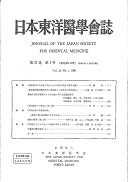All issues

Successor
Volume 19 (1968)
- Issue 4 Pages 165-
- Issue 3 Pages 123-
- Issue 2 Pages 51-
- Issue 1 Pages 1-
Volume 19, Issue 1
Displaying 1-8 of 8 articles from this issue
- |<
- <
- 1
- >
- >|
-
Kaichi MATSUSHITA1968 Volume 19 Issue 1 Pages 1-13
Published: July 30, 1968
Released on J-STAGE: October 21, 2010
JOURNAL FREE ACCESSDownload PDF (2202K) -
Kazuo TATSUNO1968 Volume 19 Issue 1 Pages 14-16
Published: July 30, 1968
Released on J-STAGE: October 21, 2010
JOURNAL FREE ACCESSDownload PDF (443K) -
ABOUT THE DIFFERENCE OF FIVE ELEMENTAL CIRCULATION BETWEEN MAN AND WOMANRokuro FUJITA1968 Volume 19 Issue 1 Pages 17-26
Published: July 30, 1968
Released on J-STAGE: October 21, 2010
JOURNAL FREE ACCESSMr. Tsutomu Kishi, the co-worker of the author, searched out meridian line intensified by one point acupuncture at the pulsdiagnosis region. As the result of this experimentation pertaining to the organ distribution of Shaku-region, he discovered that man apportioned Meimon (XIII-4) in his right hand and Curatio renis (VII-23) in his left one, and that woman's right hand concerned with Circulus meridiani renis (VIII) and her left one with Kiketsu, alias Homon, or Shiko (VIII-13). This is case by right-hander and that of left-hander in man and woman becomes mirror image.
(1) The author, also, visibly proved Mr. Kishi's discovery as skin-folds on the back by the motion of walking.
(2) The left Mobius' strip (five elemental circulation) in puls-diagnosis region decides what is called man's morphological kidney “ Tai ” and the right one woman's. Consequently, the disposition of what is called the functional kidney “ Yo ” in a broad sense, represented as Meimon (XIII-4) and Shiko (VIII-13), is contrary to that of the morphological kidney in both man and woman respectively.
These organ distribution of Shaku-region on left and right hands result from craniocaudal and dorsoventral changes of the body wall. Because man has a stress on the back and the neck, and woman on the abdomen and the tail. This also throws light on the significance of hand meridians and foot ones.
(3) As in the ancient Chinese literature written, it was ascertained from the difference in man and woman of the pulsdiagnosis by Mr. Kishi's observation that Shiko (VIII-13) was the reactionary point of the ovarium and placenta and that Meimon (XIII-4) was that of Corpus suprarenale.
(4) From the organ disposition of Shaku-region of the pulsdiagnosis caused by the kinetic antagonism in walking, a righthander has naturally a right Corpus suprarenale bigger than a left one, and the size of kidney should be in the reverse.
Relatively thinking of the statistics on Corpus suprarenale and kidney by Dr. Bunichi Sato and Dr. Saburo Aimi, which had ever performed without any relation to this study, a part of this fact was affirmed, but, more in future, I hope that this kind of observation will be advanced about the left handed-man and woman.
(5) As stated above, Shiko (VIII-13) is the reactionary point on woman and such is Meimon (XIII-4) on man. Hence Shiko (VIII-13) may be the reactionary point regarding Estrogen and such is Meimon (XIII-4) regarding Androgen.
As the fact sustaining this presumption of the author, there is A-ring in common between Androgen and Corticosteroid and they differ substantially from the ovisac hormones among hormones of the steroid group. In addition to this fact, in woman like in man, Corpus suprarenale produces Androgen considerably much. During the period of gestation Estrogen, on the contrary, is produced so much in the ovarium and the placenta, and increases a thousand times in the urine.
At the age when these modern biochemistry did not develop, I cannot help admiring precise palpation and puls-diagnosis of ancient Chinese authors who decided that Corpus suprarenale was the organ which stood for man instead of the testicles, the external abdominal organs.
In any case, prosperity will be the wider branches of study in relation to an influence which will be given upon remarkable reactionary points of Meimon (XIII-4), Shiko (VIII-13) and etc. and upon various kinds of hormone metabolism as an indicator of density of various hormones in the blood and in the urine.View full abstractDownload PDF (2095K) -
Michimasa NISHIZAWA1968 Volume 19 Issue 1 Pages 27-32
Published: July 30, 1968
Released on J-STAGE: October 21, 2010
JOURNAL FREE ACCESSDownload PDF (1513K) -
Saburo AIMI1968 Volume 19 Issue 1 Pages 33-36
Published: July 30, 1968
Released on J-STAGE: October 21, 2010
JOURNAL FREE ACCESSDownload PDF (721K) -
Teruhiro MIYASAKA1968 Volume 19 Issue 1 Pages 37-38
Published: July 30, 1968
Released on J-STAGE: October 21, 2010
JOURNAL FREE ACCESSDownload PDF (377K) -
Mitsuteru KAWAI1968 Volume 19 Issue 1 Pages 39
Published: July 30, 1968
Released on J-STAGE: October 21, 2010
JOURNAL FREE ACCESSDownload PDF (176K) -
Shigenari OGURA1968 Volume 19 Issue 1 Pages 40-41
Published: July 30, 1968
Released on J-STAGE: October 21, 2010
JOURNAL FREE ACCESSDownload PDF (225K)
- |<
- <
- 1
- >
- >|